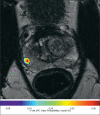Imaging of Prostate Cancer
- PMID: 34427180
- PMCID: PMC8767150
- DOI: 10.3238/arztebl.m2021.0309
Imaging of Prostate Cancer
Abstract
Background: Prostate cancer is the most common type of solid tumor in men and the second most common cause of cancer-related death in males in Germany. The conventional strategy for its primary detection, i.e., systematic ultrasound-guided prostate biopsy in men who have elevated PSA levels and/or positive findings on digital rectal examination, fails to reveal all cases. The same is true of the use of conventional computed tomography (CT), magnetic resonance imaging (MRI), and skeletal scintigraphy for the early detection of recurrences and distant metastases.
Methods: This review is based on pertinent publications retrieved by a selective search, including the German clinical practice guideline on prostate cancer and systematic review articles.
Results: Prospective multicenter trials have shown that the detection of clinically significant prostate cancer is markedly improved with multiparametric MRI (mpMRI) and MR/TRUS fusion biopsy (TRUS = transrectal ultrasonography), compared to conventional systematic biopsy. A recent Cochrane review showed that the rate of overdiagnosis of low-risk prostate cancer was reduced with mpMRI and MR/TRUS fusion biopsy compared with conventional systematic biopsy (95/1000 vs. 139/1000), and that clinically significant prostate cancer was more reliably detected (sensitivity 72% vs. 63%), albeit with slightly lower specificity (96% vs. 100%). Prostate- specific membrane antigen (PSMA) hybrid imaging improves the detection of lymphogenic and bony metastases in patients with high-risk prostate cancer. PSMA hybrid imaging is most commonly used to detect biochemical recurrences. A metaanalysis showed that the detection rate depends on the PSA concentration: 74.1% overall, 33.7% with PSA <0.2 ng/mL, and 91.7% with PSA ≥= 2.0 ng/mL.
Conclusion: The appropriate use of mpMRI and MR/TRUS fusion biopsy improves the initial detection of prostate cancer as well as the assessment of the prognosis. PSMA hybrid imaging is useful for the staging of high-risk patients and for the detection of recurrences. These methods are now recommended in the German clinical practice guideline on prostate cancer as well as in guidelines from other countries.
Figures




Comment in
-
Qualitative Data Are Lacking.Dtsch Arztebl Int. 2022 Apr 15;119(15):277. doi: 10.3238/arztebl.m2022.0114. Dtsch Arztebl Int. 2022. PMID: 35811351 Free PMC article. No abstract available.
-
In Reply.Dtsch Arztebl Int. 2022 Apr 15;119(15):277. doi: 10.3238/arztebl.m2022.0115. Dtsch Arztebl Int. 2022. PMID: 35811352 Free PMC article. No abstract available.
References
-
- Robert Koch-Institut e.V. GdeKiD. Krebs in Deutschland 2015/2016. www.krebsdaten.de/Krebs/DE/Content/Publikationen/Krebs_in_Deutschland/ki... (last accessed on 3 September 2021)
-
- Rider JR, Sandin F, Andren O, Wiklund P, Hugosson J, Stattin P. Long-term outcomes among noncuratively treated men according to prostate cancer risk category in a nationwide, population-based study. Eur Urol. 2013;63:88–96. - PubMed
-
- D‘Amico AV, Whittington R, Malkowicz SB, et al. Biochemical outcome after radical prostatectomy, external beam radiation therapy, or interstitial radiation therapy for clinically localized prostate cancer. JAMA. 1998;280:969–974. - PubMed
-
- Catalona WJ, Smith DS, Ratliff TL, et al. Measurement of prostate-specific antigen in serum as a screening test for prostate cancer. N Engl J Med. 1991;324:1156–1161. - PubMed
-
- Corcoran NM, Hong MK, Casey RG, et al. Upgrade in gleason score between prostate biopsies and pathology following radical prostatectomy significantly impacts upon the risk of biochemical recurrence. BJU Int. 2011;108(8) Pt 2 E202-10. - PubMed
Publication types
MeSH terms
LinkOut - more resources
Full Text Sources
Medical
Research Materials
Miscellaneous

